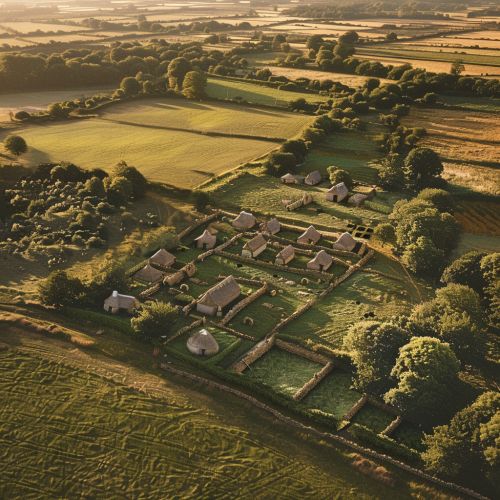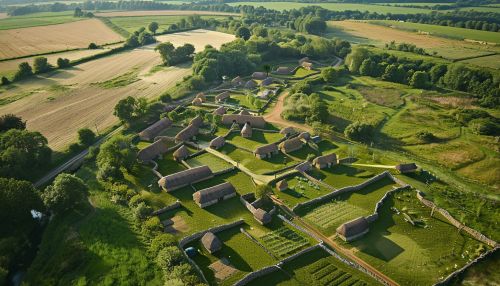Pre-Pottery Neolithic
Overview
The Pre-Pottery Neolithic (PPN) period is a significant era in the history of human civilization, marking the transition from hunter-gatherer societies to settled agricultural communities. This period, which spans approximately from 10,000 to 6,500 BCE, is characterized by the development of early farming practices, the domestication of plants and animals, and the establishment of permanent settlements. The PPN is divided into two main phases: the Pre-Pottery Neolithic A (PPNA) and the Pre-Pottery Neolithic B (PPNB). These phases are distinguished by differences in architecture, tool technology, and subsistence strategies.
Archaeological Context
The Pre-Pottery Neolithic period is primarily identified through archaeological excavations in the Near East, particularly in regions such as the Levant, Anatolia, and Mesopotamia. Key sites include Jericho, Göbekli Tepe, and Çatalhöyük. The absence of pottery distinguishes this period from the subsequent Pottery Neolithic period.
Pre-Pottery Neolithic A (PPNA)
The PPNA phase, dating from around 10,000 to 8,800 BCE, is marked by the establishment of the first sedentary communities. One of the most notable sites from this period is Jericho, which features a massive stone wall and tower, indicating advanced construction techniques and social organization.
Pre-Pottery Neolithic B (PPNB)
The PPNB phase, spanning from approximately 8,800 to 6,500 BCE, saw significant advancements in architecture, with the construction of rectangular, multi-roomed houses. This period also witnessed the widespread domestication of plants such as wheat, barley, and legumes, as well as animals like sheep, goats, and cattle.
Technological Innovations
The Pre-Pottery Neolithic period is notable for several technological innovations that laid the foundation for future advancements. These include the development of ground stone tools, such as axes and adzes, which were used for woodworking and construction. Additionally, the production of plaster from lime and the use of mudbrick for building construction became widespread.
Lithic Technology
Lithic technology during the PPN is characterized by the production of microliths, small stone tools that were often used as components of composite tools. The PPNB phase saw the introduction of pressure flaking techniques, which allowed for the creation of more refined and standardized tools.
Architectural Advances
The architectural advances of the PPN period include the construction of large communal structures, such as the circular enclosures at Göbekli Tepe. These structures are believed to have served ritual or ceremonial purposes, indicating the presence of complex social and religious practices.
Subsistence Strategies
The transition from foraging to farming during the PPN period represents a major shift in human subsistence strategies. This shift is often referred to as the Neolithic Revolution.
Agriculture
The domestication of plants and animals during the PPN period allowed for the development of agriculture, which provided a more reliable and abundant food supply. Early farmers cultivated a variety of crops, including emmer wheat, einkorn wheat, barley, and lentils. The domestication of animals provided additional resources, such as meat, milk, and wool.
Hunting and Gathering
Despite the advent of agriculture, hunting and gathering continued to play a significant role in PPN societies. Archaeological evidence indicates that wild game, such as gazelle and deer, remained an important part of the diet.
Social Organization
The Pre-Pottery Neolithic period saw the emergence of more complex social structures, as evidenced by the construction of large communal buildings and the presence of elaborate burial practices.
Settlement Patterns
PPN settlements were typically characterized by densely packed houses, often with shared walls. This suggests a high degree of social cohesion and cooperation. The presence of communal structures, such as the tower at Jericho and the enclosures at Göbekli Tepe, indicates the existence of organized labor and possibly hierarchical social structures.
Burial Practices
Burial practices during the PPN period varied widely, with some individuals being buried within the settlement, often beneath the floors of houses. This practice suggests a strong connection between the living and the dead. Some burials also included grave goods, such as tools and ornaments, indicating the presence of social differentiation.
Art and Symbolism
The Pre-Pottery Neolithic period is notable for its rich artistic and symbolic expressions. These include figurines, carvings, and wall paintings, which provide insights into the beliefs and practices of PPN societies.
Figurines
Clay and stone figurines, often depicting humans and animals, are common finds at PPN sites. These figurines are believed to have had ritual or symbolic significance, possibly related to fertility or ancestor worship.
Carvings and Paintings
Carvings and wall paintings from the PPN period often depict geometric patterns, animals, and human figures. These artworks are thought to have served both decorative and symbolic purposes, reflecting the cultural and religious beliefs of PPN communities.
Environmental Impact
The shift to agriculture during the PPN period had significant environmental impacts, including deforestation, soil erosion, and changes in local ecosystems. The introduction of farming practices led to the clearing of large areas of land for cultivation, which in turn affected the natural vegetation and wildlife.
Deforestation
The need for arable land and building materials resulted in widespread deforestation. This had long-term consequences for the environment, including changes in soil composition and increased vulnerability to erosion.
Soil Erosion
The intensive farming practices of the PPN period, combined with deforestation, contributed to soil erosion. This would have affected agricultural productivity and may have necessitated the development of new farming techniques to maintain soil fertility.
Legacy
The Pre-Pottery Neolithic period laid the foundations for many aspects of modern civilization, including agriculture, permanent settlements, and complex social structures. The innovations and developments of this period had a profound and lasting impact on subsequent human societies.
Influence on Later Cultures
The advancements made during the PPN period influenced later Neolithic cultures, particularly in terms of agricultural practices and architectural techniques. The domestication of plants and animals during this period provided the basis for the agricultural economies of later civilizations.
Archaeological Significance
The study of the Pre-Pottery Neolithic period provides valuable insights into the origins of agriculture and the development of early human societies. Ongoing archaeological research continues to uncover new information about this pivotal period in human history.
See Also


References
- Bar-Yosef, O. (1998). The Natufian Culture in the Levant, Threshold to the Origins of Agriculture. Evolutionary Anthropology, 6(5), 159-177.
- Kuijt, I. (2000). People and Space in Early Agricultural Villages: Exploring Daily Lives, Community Size, and Architecture in the Late Pre-Pottery Neolithic. Journal of Anthropological Archaeology, 19(1), 75-102.
- Rollefson, G. O. (1989). The Late Aceramic Neolithic of the Levant: A Synthesis. Paléorient, 15(1), 168-173.
